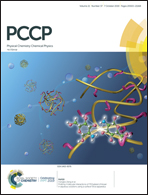Equilibration of molecules between two compartments through a nanochannel in the presence of osmolytes: a molecular dynamics simulation study
Abstract
Using molecular dynamics simulations, we study the equilibration of a system consisting of two nanoscale compartments connected by a carbon nanotube through which small mobile molecules can pass. The system is initially in a state where only one compartment is filled with molecules and the other is empty. When the molecules are allowed to move from the filled compartment to the empty one, the system starts equilibrating and finally reaches an equilibrium state where the molecules are distributed between the two compartments. In the absence of osmolytes, the equilibrium distribution of molecules is simply determined by the relative volumes of the compartments, but in the presence of osmolytes, the distribution is dependent on not only the relative compartment volumes but also the osmolyte properties. To systematically study the effect of osmolytes, we investigate how the number of osmolytes and the strength of the interaction between molecules and osmolytes affect the equilibrium state. Interestingly, we find that osmolytes strongly interacting with molecules can drain the initially filled compartment and induce the complete transfer of molecules to the initially empty compartment. We also study the kinetic and thermodynamic aspects of the equilibration processes.



 Please wait while we load your content...
Please wait while we load your content...